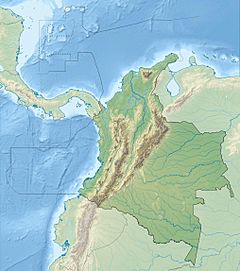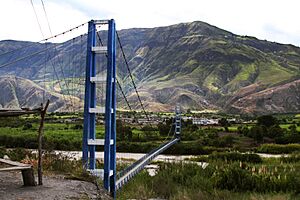Mira River (Ecuador and Colombia) facts for kids
Quick facts for kids Mira River |
|
|---|---|
|
Mira River mouth
|
|
| Countries | Ecuador, Colombia |
| Physical characteristics | |
| Main source | Puruanta Lake, Ecuador |
| River mouth | Pacific Ocean 0 m (0 ft) 1°36′00″N 79°01′00″W / 1.6°N 79.016667°W |
The Mira River is a cool river that starts high up in the Andes mountains in Ecuador. It flows all the way to the Pacific Ocean in Colombia. For a short distance, it even forms the border between these two countries!
The top part of the Mira River is called the Chota River. This area is special because of its Afro-Ecuadorian people, their lively bomba music, and how many amazing soccer players have come from there.
Contents
Where the Mira River Flows
Starting High in the Andes
The Mira River might start from a lake called Puruanta Lake. This lake is very high up, about 3,473 metres (11,394 ft) above sea level, in a place called the Cayambe Coca Ecological Reserve in northern Ecuador.
Cities like Ibarra and Otavalo are in the area where the river collects its water. This includes most of the Imbabura and Carchi provinces. The borders of these two provinces generally follow the path of the Mira River.
The Chota Valley: A Special Place
Several smaller rivers join together to form the Chota River. This happens north of the town of Pimampiro, at an elevation of about 1,700 metres (5,600 ft).
The Chota valley is quite deep, but it has wide and fertile areas. It stretches for about 35 kilometres (22 mi) along the river. Below where the Chota and Piguchuela rivers meet, the river officially becomes the Mira River.
The climate here is quite dry, with only about 500 millimetres (20 in) of rain each year. Because of this, farmers need to use irrigation to grow most of their crops.
For a very long time, even before the Spanish arrived, people used the Chota Valley to grow warm-weather crops. These included plants like coca, cotton, chile peppers, maize (corn), and various fruits. Traders would exchange these crops with people living in the cooler, higher mountains nearby. Later, the Spanish brought new crops like sugar cane, olives, and grapes.
Through Narrow Canyons
A few miles north of Concepcion, the Mira River enters a narrow canyon. This area doesn't have many people living in it. The canyon is surrounded by forests and drops in height over about 100 kilometres (62 mi). It goes from about 1,200 metres (3,900 ft) near Concepcion down to 100 metres (330 ft).
This part of the Mira River, and the Chota Valley upstream, is popular for exciting activities like rafting and kayaking. There are many fun and challenging rapids here!
Reaching the Coast
The Mira River can be traveled by boat for about 88 kilometres (55 mi) as it flows through the Nariño Department in Colombia to the Pacific Ocean. A big river called the San Juan River joins the Mira here.
This coastal area is a rainforest region. Not many people live here, and most of them grow bananas and African oil Palm.
People, Music, and Soccer
Afro-Ecuadorian History
Starting in the 1500s, African people were brought to Ecuador. In the 1600s and 1700s, a group called the Jesuit missionaries owned most of the land in the Chota valley. They brought many African people to work on their sugar cane farms. By 1767, the Jesuits owned 10 farms and had 1,769 enslaved people in the Chota valley. Even after the Jesuits left, most of the Afro-Ecuadorians continued to be enslaved by the new farm owners.
Slavery was ended in Ecuador in 1852. After this, most Afro-Ecuadorians in the Chota Valley became sharecroppers. This meant they worked on land owned by others and shared their crops. This situation continued for a long time. In 1987, almost all the people in the Chota Valley were Afro-Ecuadorian, living in about 10 to 15 villages. The areas around them had people of mixed heritage and Indigenous people.
Some Afro-Ecuadorians were able to get their own land after new laws in 1964. However, even in the early 2000s, many Afro-Ecuadorians in the Chota valley were still struggling and had little or no land.
Bomba Music and Soccer Stars
The Chota valley is famous for its "bomba" music. This music uses African drums mixed with sounds from Indigenous and Spanish cultures.
The valley has also become known for producing many of Ecuador's best soccer players! In 2002, the Ecuadorian team that played in the FIFA World Cup had seven Afro-Ecuadorian players from the Chota valley on its roster. This is amazing, especially since the Chota valley didn't even have proper grass soccer fields or training places for young players.
See also
 In Spanish: Río Mira (Colombia-Ecuador) para niños
In Spanish: Río Mira (Colombia-Ecuador) para niños



